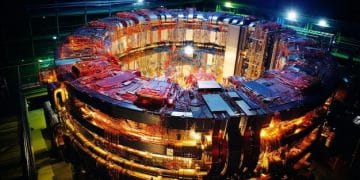MLS Attendance Trends: Driving Growth and Maximizing Opportunities

MLS attendance trends show consistent growth, driven by factors like strategic marketing, enhanced stadium experiences, and increased fan engagement, which teams can capitalize on by focusing on data-driven decisions and leveraging community connections to enhance growth and revenue.
The MLS attendance trends: what’s driving growth and how can teams capitalize? is a hot topic in the soccer world. Major League Soccer (MLS) has seen a steady rise in attendance. Understanding the factors behind this growth is crucial for teams looking to further capitalize on this trend.
Understanding Major League Soccer’s Attendance Growth
Major League Soccer (MLS) has experienced remarkable growth in recent years. This is especially true when considering attendance numbers. The increasing popularity of soccer in the United States and Canada is evident. It shows the rising engagement of fans with their local teams. So what factors are the key drivers for this consistent growth?
The Broader Appeal of Soccer
Soccer’s accessibility and global appeal make it attractive to a diverse audience. This includes families, young adults, and international communities. The sport’s simple rules and universal language make it easy for anyone to understand and enjoy. This leads to broader adoption and interest, boosting attendance figures.
Strategic Marketing and Promotion
MLS teams have become increasingly sophisticated in their marketing efforts. They use data analytics to target specific demographics and tailor promotions to engage potential fans. These strategies include social media campaigns, community outreach programs, and ticket bundling options. These targeted approaches have proven effective in drawing more fans to the stadiums.

Here are key points about how these elements drive growth:
- Community Engagement: Local events, youth programs, and partnerships with community organizations help build a loyal fan base.
- Digital Marketing: Targeted ads, social media interactions, and engaging content increase awareness and drive ticket sales.
- Promotional Offers: Ticket discounts, family packages, and themed nights create incentives for attending games.
In conclusion, understanding the multifaceted reasons behind MLS attendance growth requires a deep dive into both the game’s inherent appeal and strategic marketing efforts. The combination of these elements has significantly contributed to the league’s sustained success in drawing crowds.
The Impact of Stadium Experience on MLS Attendance
The stadium experience plays a pivotal role in driving attendance for Major League Soccer (MLS) games. A positive and engaging environment can transform a casual observer into a season-ticket holder. Here’s how the match day experience impacts attendance, from stadium amenities to the overall atmosphere.
Upgraded Stadium Amenities
Modern MLS stadiums offer a range of amenities designed to enhance the fan experience. These include comfortable seating, high-quality food and beverage options, and state-of-the-art video screens. These features not only make the game more enjoyable, but also encourage fans to spend more time at the venue, boosting revenue and overall satisfaction.
Creating a Unique Atmosphere
MLS teams are increasingly focused on creating a unique and memorable atmosphere at their games. This includes pre-match entertainment, live music, and interactive fan zones. Many teams also work closely with supporters’ groups to foster a sense of community and create an electric atmosphere during matches. This increases the appeal of attending games.

Key elements for creating a memorable atmosphere include:
- Pre-Game Festivities: Fan zones with games, music, and food vendors create a lively environment before kickoff.
- In-Game Entertainment: Live music, halftime shows, and interactive contests keep fans engaged throughout the match.
- Supporter Group Integration: Working with passionate fan groups to organize chants, displays, and other forms of support enhances the game day experience.
In summary, the stadium experience is a critical factor in driving MLS attendance. With strategic investments in stadium amenities and fostering a unique atmosphere, teams can significantly enhance fan engagement. This leads to increased ticket sales and greater loyalty.
Effective Strategies for MLS Teams to Boost Attendance
To maximize attendance, MLS teams need to implement targeted strategies. These are designed to appeal to both current and potential fans. Implementing these strategies can significantly enhance game day attendance. What are the most effective approaches to boost these numbers?
Data-Driven Decision Making
Data analytics should drive marketing and promotional efforts. By analyzing ticket sales, demographics, and fan feedback, teams can identify opportunities for targeted campaigns. Teams can use this data to customize their outreach efforts. This in turn makes them more effective in attracting fans to games.
Leveraging Community Connections
Building strong relationships with local communities is crucial for sustaining long-term attendance growth. Teams should actively participate in community events, support local charities, and partner with youth soccer organizations. It fosters a sense of belonging. This can translate into increased attendance, as fans feel more connected to their local team.
Effective strategies include:
- Targeted Advertising: Tailoring ads to specific demographics and interests increases the likelihood of attracting new fans.
- Partnerships: Collaborating with local businesses and organizations can expand reach and engagement within the community.
- Community Events: Participating in local festivals and sponsoring youth sports teams fosters a sense of connection and loyalty.
In conclusion, effective attendance-boosting strategies require a dual focus on data-driven decision-making and strong community connections. By understanding their audience and investing in local relationships, MLS teams can create a loyal fan base. It ensures robust attendance figures.
Analyzing Fan Demographics and Preferences in MLS
Understanding fan demographics and preferences is essential for MLS teams. This helps tailor marketing strategies. By understanding their audience, teams can create targeted campaigns. These campaigns can generate increased interest and attendance. How do teams effectively analyze these demographics and preferences?
Conducting Fan Surveys and Research
Fan surveys and research provide valuable insights into demographics, interests, and motivations. Teams can gather data on ticket purchasing habits, game day experiences, and preferences for stadium amenities through these methods. This data can then be used to refine marketing strategies and improve the overall fan experience.
Utilizing Social Media Insights
Social media platforms offer a wealth of information about fan demographics and preferences. Teams can track engagement metrics, analyze follower demographics, and monitor conversations to gain insights into what resonates with their audience. This helps the team enhance the approach the social platform. The team can also tailor content to specific interests.
Effective analysis involves:
- Data Analysis: Regularly analyzing ticket sales, survey results, and social media data to identify trends and opportunities.
- Segmentation: Dividing fans into distinct groups based on demographics, interests, and behaviors to tailor marketing and promotional efforts.
- Personalization: Using data to personalize communications and offers, making fans feel valued and understood.
In conclusion, analyzing fan demographics and preferences is a continuous process. It requires ongoing surveys, research, and social media insights. By gaining a deeper understanding of their audience, MLS teams can create more effective marketing strategies, enhance the fan experience, and drive attendance.
The Role of Ticket Pricing and Packages in MLS Attendance
Ticket pricing and packages play a significant role in influencing MLS attendance. Teams need to strike a balance between affordability and revenue generation. Effective pricing strategies can attract a broader range of fans. How do teams navigate this delicate balance to maximize attendance?
Dynamic Pricing Strategies
Dynamic pricing involves adjusting ticket prices based on factors such as opponent, day of the week, and seat location. Teams can use this strategy to maximize revenue for high-demand games. They can also offer discounts for less popular matches. Dynamic pricing ensures that the stadium is filled, without undervaluing tickets.
Offering Flexible Ticket Packages
Flexible ticket packages cater to different fan preferences and budgets. These can include season ticket options, partial season plans, and group ticket discounts. Offering a variety of packages makes attending games more accessible and affordable for a wider range of fans. This leads to increased purchases.
Key considerations for pricing and packages include:
- Value Perception: Ensuring that fans perceive the ticket price as fair relative to the overall experience and entertainment value.
- Accessibility: Offering a range of ticket options to accommodate different budgets and preferences.
- Incentives: Providing discounts, perks, and other incentives to encourage ticket purchases and renewals.
In summary, ticket pricing and packages are critical tools for driving MLS attendance. Strategic pricing and flexible package options appeal to a wide range of fans. This maximizes stadium occupancy and revenue. Successfully implementing these strategies is essential.
Future Trends in MLS Attendance and Fan Engagement
Looking ahead, MLS attendance and fan engagement are set to evolve. By understanding and adapting to these changes, teams can maintain their competitive edge. What are the key trends shaping the future of fan experience?
Embracing Technology
Technology will continue to play a growing role in enhancing the fan experience. This includes mobile ticketing, in-stadium Wi-Fi, and augmented reality applications. These technologies offer convenience, engagement opportunities, and personalized experiences. They elevate the overall game day experience.
Personalized Fan Experiences
Personalization is a key trend in fan engagement. Teams can use data analytics to tailor content, offers, and communications to individual fan preferences. This creates a more engaging and rewarding experience. Personalization encourages greater loyalty and attendance.
Future trends also include:
- Sustainability: Implementing eco-friendly practices and promoting sustainability initiatives to appeal to environmentally conscious fans.
- Esports Integration: Integrating esports and gaming elements into the fan experience to attract younger demographics.
- Global Expansion: Expanding the league’s global reach through international partnerships, tournaments, and marketing efforts to attract a wider audience.
In conclusion, the future of MLS attendance and fan engagement looks promising. This is thanks to continuing advancements in technology, personalized experiences, and a focus on sustainability and global outreach. Embracing these trends is crucial for MLS teams. It will help them to stay relevant, attract new fans, and continue to grow the sport’s popularity.
| Key Point | Brief Description |
|---|---|
| 📈 Attendance Growth | Strategic marketing and fan engagement initiatives drive increasing attendance. |
| 🏟️ Stadium Experience | Upgraded amenities and unique atmospheres enhance fan satisfaction and drive attendance. |
| 📊 Data Analysis | Data-driven decisions and understanding fan preferences boost marketing effectiveness. |
| 🎫 Ticket Strategies | Flexible pricing and diverse ticket packages cater to a wide range of fans. |
Frequently Asked Questions
The growth in MLS attendance is due to strategic marketing, community engagement, upgraded stadium experiences, and the increasing popularity of soccer in North America.
Upgraded amenities, such as comfortable seating and diverse food options, enhance the fan experience. This makes games more appealing and encourages higher attendance rates.
Effective ticket pricing strategies include dynamic pricing, flexible ticket packages, and offering discounts for groups, families, and less popular matches.
By analyzing fan demographics and preferences, teams can tailor marketing and promotional efforts. The data analysis enables targeted campaigns and personalized experiences.
Future trends include embracing technology, creating personalized fan experiences, focusing on sustainability, and integrating esports and gaming elements to appeal to younger fans.
Conclusion
In conclusion, the growth of MLS attendance is influenced by numerous factors including strategic marketing, improved stadium experiences, and effective community engagement. By understanding fan demographics, implementing targeted strategies, and embracing future trends, MLS teams can capitalize on these trends and continue to grow their fan base. Data analysis and adaptable ticket pricing are also key for future success.





